History
The Church of the Holy Rood originated as a parochial chapel, belonging to Coombe Keynes until 1844, when Wool became a separate parish.
In 1384 it was decreed that Wool Chapel should be dedicated for the third time, and since then, with its Mother Church at Coombe Keynes (made redundant 14th January 1974), it has been dedicated to Holy Rood.
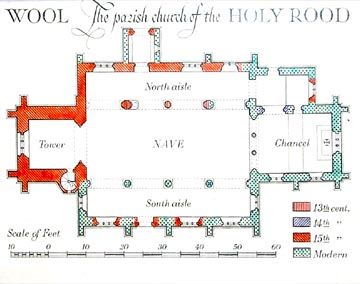
According to Hutchins in his History of Dorset, the church on this site consisted originally of only a nave. The chancel and tower were added later, about 1450.
From then until 1865, the church consisted of the original nave, a small chancel, tower and a north arcade.
In 1865 a faculty was issued to pull down the body of the church and chancel with the exception of the tower and north and east walls of the nave and to build a south aisle. The church was lengthened by 12 feet.
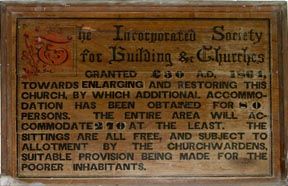
The result was the church as we see it now. The extension included the ancient burial place of the Turbervilles of Wool Bridge. The architect was John Hicks of Dorchester.
Text based on the Holy Rood Guide written by the late Mr Alan Brown (2003) and used by permission.
Alan was also the author of three excellent books on local history: "A Backward Glimpse of Wool", "The Changing Face of Wool", and "More Memories of Wool".
Sadly Alan died in 2020, but all three books are available from "Willowmead", East Burton Road, Wool, Wareham, Dorset, BH20 6HG where his family still may be contacted.
Features

Stonework
The nave and chancel are mostly built using local Heathstone with scattered blocks of Purbeck Limestone. Limestone is also used for quoins (corner stones) and dressings, while the porch and most of the windows are made from Bath Stone. The 15th-century tower is wholly built from Purbeck Limestone, mostly a broken-shell limestone known as "Burr".
A detailed survey of the Holy Rood stonework was undertaken by Dorset Geology History expert Jo Thomas in 2018, the results of which can be found on the Dorset Building Stone website here: https://dorsetbuildingstone.weebly.com/wool.html
It describes the different places the stone has come from at different times in the building's history, and has many interesting pictures.
Bindon Chapel
 
The small chapel in the north east corner is the Bindon Chapel which was once larger than at present, as part of it was taken in when the vestry was enlarged.
This picture shows the painting before its repair and restoration.
Murillo-style painting
For some time the above painting of Mary belonging to Holy Rood Church was in storage as its condition was deteriorating. It was given to the Church by the Revd Eric Tarrant who was Vicar of Wool from 1929-40. The painting probably dates from the late eighteenth or early nineteenth century, but draws its inspiration from the work of the seventeenth century Spanish artist Murillo. Towards the end of 2007, the Parochial Church Council decided to have it restored by a professional conservator. The work included strip-lining and re-stretching the canvas, cleaning the surface and repairing some minor damage. It has also been re-framed in line with the conservator’s recommendations and re-hung in the Bindon Chapel.
North Porch
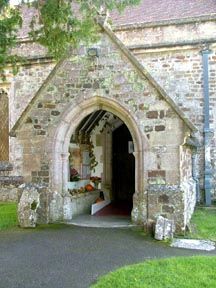
The North Porch, although rebuilt in 1866, retains much of its 15th century appearance.
Triple Arch
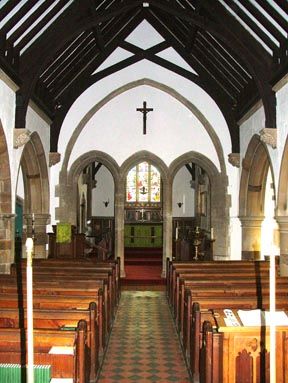
The special feature of the church is the triple chancel arch, which is possibly unique. The tympanum is plain and the whole screen dates from the middle of the 14th century.
Windows
The windows are mainly 15th century and were re-used in the 1866 rebuilding.
Coombe windows
The stained glass windows on the north side  were removed from Coombe Keynes church at the time of its redundancy. were removed from Coombe Keynes church at the time of its redundancy.

Font
The font and the two stone arches on the north side are 15th century.
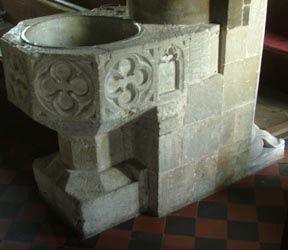
Coombe Stoup
 The water stoup exhibited on the window sill in the north aisle was once fitted into the wall of Coombe Keynes Church and removed in 1974. The water stoup exhibited on the window sill in the north aisle was once fitted into the wall of Coombe Keynes Church and removed in 1974.
The cresset stone 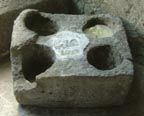 (also on the north window sill) containing four receptacles in which wicks floating in oil were burnt before a shrine, is a fine example of mediaeval work, and was discovered during the rebuilding in 1866. (also on the north window sill) containing four receptacles in which wicks floating in oil were burnt before a shrine, is a fine example of mediaeval work, and was discovered during the rebuilding in 1866.
The Flute
The flute was stolen some years ago from the church by someone who must have thought it was valuable. It wasn't, but it was interesting because it linked us to the times when it was one of the instruments belonging to the church band, before the organ was introduced. have thought it was valuable. It wasn't, but it was interesting because it linked us to the times when it was one of the instruments belonging to the church band, before the organ was introduced.
The band would probably have played in the west gallery, which in the 3rd edition of Hutchins' History Of Dorset was referred to as follows: "In 1852 the interior arrangement of the church was improved by the removal of the singing gallery to its present position behind the tower arch. It formerly extended much further into the church and was a great source of disfigurement"
West Gallery bands and choirs ("Quires") were a common feature of village church musical life in those days. Nowadays we may not have the gallery, but still welcome the performances from the group "Purbeck Village Quire" who generously offer their time and skills to let us sample some of the old music, readings, costumes and atmosphere still surviving from former days.
George III Plaque
A Coat of Arms of George III hangs on the rear wall in the body of the church and dates from prior to 1801.
 After King Henry VIII had placed himself as head of the new Church of England, it became a legal requirement to display the Royal Arms inside parish churches throughout the land. The Royal Arms were usually painted on a rectangular piece of wood or cloth and hung in a prominent place for all the congregation to see. (The King presumably was keen to emphasise that he was now the head of the new Church of England, and not the Pope.) After King Henry VIII had placed himself as head of the new Church of England, it became a legal requirement to display the Royal Arms inside parish churches throughout the land. The Royal Arms were usually painted on a rectangular piece of wood or cloth and hung in a prominent place for all the congregation to see. (The King presumably was keen to emphasise that he was now the head of the new Church of England, and not the Pope.)
Parish records indicate that the Holy Rood plaque was commissioned in around 1793 by John Brown, who was Churchwarden from about 1790 to 1798. It’s possible that he commissioned the work from a local painter of pub signs, which was common practice at the time. John Brown was also chairman of the Poorhouse Committee, but he was evidently relieved of his post since he never attended a meeting!
George III reigned from 1760 to 1820. In 1800, the King abandoned his ancestors’ claim to the French throne. We can be certain that our plaque was painted before 1801 because in that year, the French insignia (the fleurs-de-lys on a blue background) was dropped from the top right corner of the royal shield to be replaced by the arms of Scotland (a red lion on a yellow background).
Our Coat of Arms was magnificently brought back to life in 2019 by art restorer Tim Everett of Taunton, following a very generous gift from Holy Rood’s retiring Churchwarden, Commodore Geoffrey Edwardes R.N. O.B.E.
This enabled the fully restored plaque to be rehung in August 2019.
(Geoff, a retired Royal Naval officer who served as Churchwarden for eight years, worked long and hard to overcome numerous obstacles and get the necessary permissions, liaising closely with the conservators throughout the process.)
Shepherd's Crook
 The shepherd's crook displayed in the north window sill was used by Walter 'Shep' Trevett, a local shepherd, who for many years before the days of electricity pumped the organ for services until the 1930s. The shepherd's crook displayed in the north window sill was used by Walter 'Shep' Trevett, a local shepherd, who for many years before the days of electricity pumped the organ for services until the 1930s.
 The brass eagle lectern was given as a memorial to Mr Plumber the organist in the early part of the 20th century. The brass eagle lectern was given as a memorial to Mr Plumber the organist in the early part of the 20th century.
 The crucifix above the chancel arch was given by the late Mr S. J. Tong. It was carved by Mr Edward Tong in memory of two sons, Herbert, who died of wounds in 1917, and Arthur who died some years later from wounds received in 1918. The crucifix above the chancel arch was given by the late Mr S. J. Tong. It was carved by Mr Edward Tong in memory of two sons, Herbert, who died of wounds in 1917, and Arthur who died some years later from wounds received in 1918.
The pulpit was removed from St. Mary the Virgin, East Stoke, 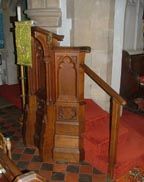 on its redundancy and replaced the stone pulpit which stood on the opposite side of the aisle. on its redundancy and replaced the stone pulpit which stood on the opposite side of the aisle.
The reredos at the rear of the altar 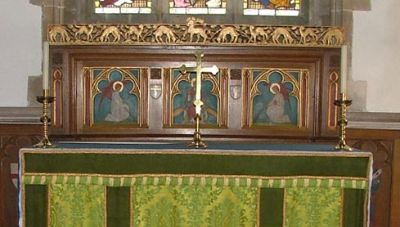 was made in 1925. was made in 1925.
The church possesses an ancient altar frontal, which is in the custody of the Dorchester Museum. 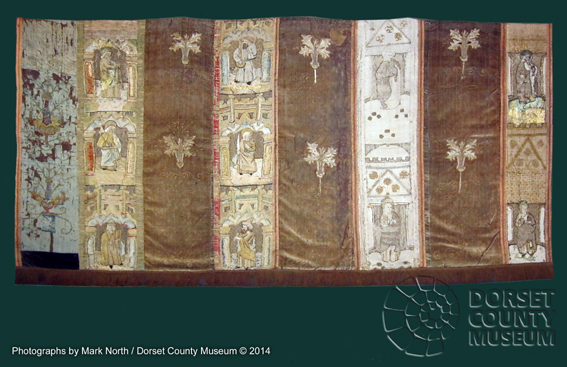 It was made up from portions of 15th and 16th century vestments in eight vertical strips. The vestments are thought to have come from Bindon Abbey after the Reformation. It was made up from portions of 15th and 16th century vestments in eight vertical strips. The vestments are thought to have come from Bindon Abbey after the Reformation.
See the seperate page for more information.
Chalices
The church possesses an Elizabethan chalice with a cover originally used as a paten, bearing the date 1571.
There is also an earlier silver chalice of national and possibly international importance, belonging to the church and in the custody of Dorchester Museum. (It is said to be one of the finest examples of an English pre-reformation silver chalice in existence.)
Coombe Keynes Chalice
The Coombe Keynes Chalice, which belongs to the PCC of Wool and East Stoke, is an object of huge national importance. Currently it is on loan to the Dorchester County Museum, who have told us it is on public display.
In Holy Rood Church, Wool, we use in our Communion Services a replica of this precious 15th century chalice.
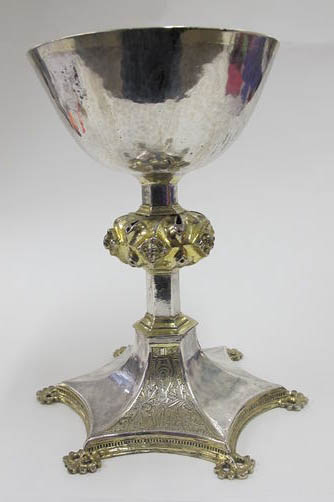
The replica (in silver plate) was made in modern times.
The following information is adapted from the description on the Victoria and Albert Museum website:
Dated around A.D. 1500 by an unknown artist, the chalice is made of silver; with parcel-gilt1. It was used during the Mass to serve the consecrated wine. The form and ornament of chalices usually reflects current artistic styles and religious practice. This one shows some of the decorative motifs that were common before the Reformation. Its form, with a pierced knop (the bulbous swelling on the stem) and hexagonal foot with embellished angles, is typical of chalices made in England during the late 15th century. The foot is engraved with a crucifix amid decorative foliage.
Ref: http://collections.vam.ac.uk/item/O104962/the-coombe-keynes-chalice-chalice-unknown/
1 ‘Parcel-gilt’ - that is to say, it is partially gold-plated
Extract from "The Heart of Wessex" by Sidney Heath (written in 1910)
“Coombe Keynes is situated a mile or so to the south of Wool, its chief claim to notice being the singularly beautiful pre-Reformation chalice preserved within the church, a building that was extensively restored in 1860. The chalice is one of three pieces of pre-Reformation church plate that now remain in the county, although out of some three hundred parishes over one hundred have retained their Elizabethan chalices, while seventy possess Communion plate of the seventeenth century.
The Coombe Keynes chalice is in excellent condition, and is surpassed in beauty only by the very similar but slightly earlier example at Wylye, in Wiltshire. Its height is 63/8 inches; diameter of bowl, 4 inches; depth, 2 inches; narrowest part of base, 33/8 inches; widest part, 5¼ inches. The bowl is broad and conical; the slender stem hexagonal and quite plain, with ogee moulded bands at the junctions. The knob is full sized, having six lobes spirally twisted with traceried openings, terminating in angels' heads, crowned. The date is about 1500, if not somewhat earlier. The two other examples of pre-Reformation plate in Dorset are a paten at Buckhorn Weston, and a chalice at Sturminster Marshall.” [Ref: http://www.gutenberg.org/files/46839/46839-h/46839-h.htm ]
The Bells
An ancient rhyme regarding the twelve bells from Bindon Abbey at the time of the Dissolution of the Monasteries reads: “Wool streams and Coombe wells, Fordington cuckolds stole Wool bells.” The bells were believed to have been hidden in a lane near the church and removed by men from Fordington St George. The lane was later called Bell Drong. (Drong is a West Country word for a narrow lane.) Eventually, Fordington, Wool, and Coombe Keynes shared the bells.
A large photograph of the six bells (reproduced below) hangs in the ringing chamber. It is inscribed:
“In commemoration of the re-hanging of Wool Bells, with the addition of two new ones in 1907, and in memory of the Rev. A.C.B. Dobie, M.A. who whilst Vicar of Wool from 1896 to 1912 was mainly responsible for this work. He loved his church and served it faithfully. Given by his son.”
There are six bells still used regularly. There were only four originally, with another two added in 1907.
The bells' details are:
|
Treble
|
Note E
|
2cwt 2qtrs 8lbs
|
1907
|
|
Second
|
Note D
|
3cwt 2qtrs
|
1606
|
|
Third
|
Note C
|
4cwt
|
1738
|
|
Fourth
|
Note B
|
6cwt 2qtrs
|
1606
|
|
Fifth
|
Note A
|
8cwt 2qtrs
|
1659
|
|
Tenor
|
Note G
|
11cwt 0qtrs 24lbs
|
1907
|

Inscriptions and makers:
1. "In loving memory of my dear mother and my dear grandmother Caroline Esther Hedgecock. 1906. Florence Dobie. John Dobie 1907."
Gillett & Johnson, Croydon
2. "Love God" 1606
John Wallis, Salisbury
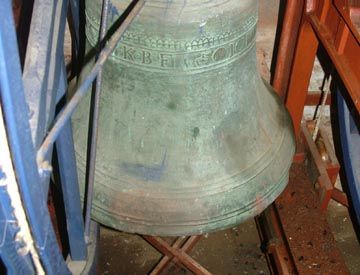 3. "John Hayte CW. Anno 1738. WKBF" (pictured right) 3. "John Hayte CW. Anno 1738. WKBF" (pictured right)
"WKBF" is probably William Knight, Master Bell-Founder in Closworth Bell Foundry from 1709-47.
4. "Serve God. W. 1606"
John Wallis, Salisbury
5. "C. W. T. B. Anno Domini 1659".
Possibly by Thomas Purdue, Master Bell-Founder in Closworth Bell Foundry from 1647-1691.
6. "These bells rehung, tenor and treble added, 1907. Arthur C.B. Dobie, Vicar. Jas. Spicer and Walter Wright, churchwardens."
Gillett & Johnson, Croydon
An ancient rhyme regarding the twelve bells from Bindon Abbey at the time of the Dissolution of the Monasteries reads: “Wool streams and Coombe wells, Fordington cuckolds stole Wool bells.” The bells were believed to have been hidden in a lane near the church and removed by men from Fordington St George. The lane was later called Bell Drong. (Drong is a West Country word for a narrow lane.) Eventually, Fordington, Wool, and Coombe Keynes shared the bells.
Registers
The registers of Wool and Coombe Keynes dated from 1583 are now in the County Archives at Dorchester.
Former vicars
The previous vicars of Wool and East Stoke are listed at the back of the church.
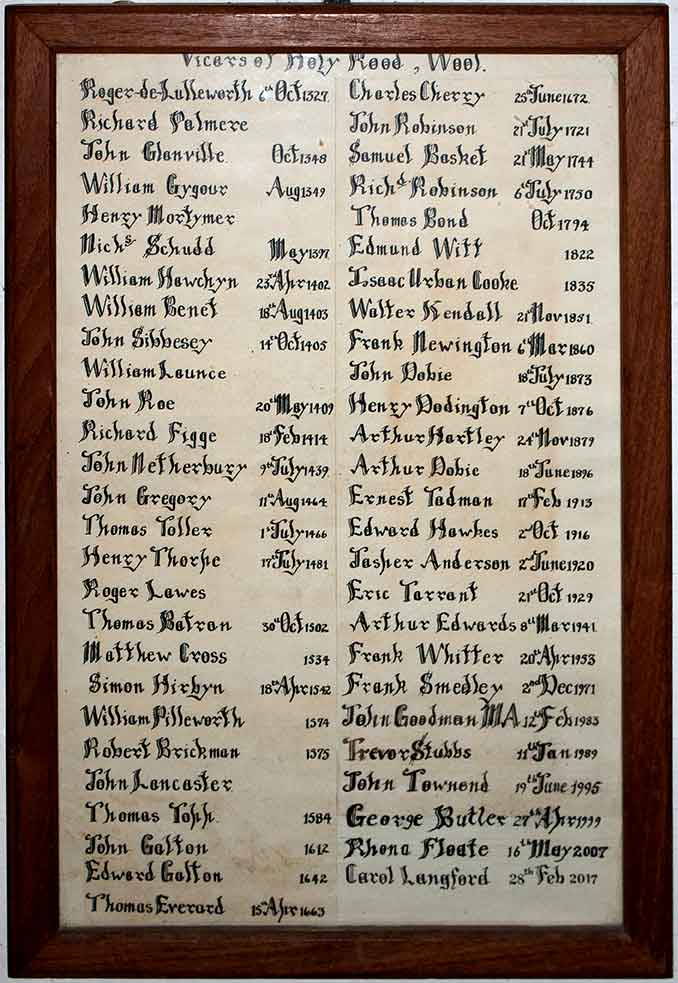 
The War Memorial in the churchyard  is a plain Latin cross and was erected in 1921. is a plain Latin cross and was erected in 1921.
Setting
Although the church now stands on the edge of the village, it was not always so.
 Church Lane was once a busy road. A hundred yards past the church the road reached a junction: one road to East Stoke, another through Wood Street and into Purbeck, and yet another to Coombe Keynes, running parallel some quarter of a mile east of the present road. Church Lane was once a busy road. A hundred yards past the church the road reached a junction: one road to East Stoke, another through Wood Street and into Purbeck, and yet another to Coombe Keynes, running parallel some quarter of a mile east of the present road.
Hutchins 3rd edition also referred to the position of the church: " - it is conveniently situated on gently rising ground in the Southern part of the village. There is a tradition among the people, that some time ago it formed the central point of the village; and within the memory of the present generation, changes have taken place which have made it less so than formerly, some houses near the church having been pulled down, and others built at a greater distance, in common, Bindon Lane etc."
Text based on the current Holy Rood Guide written by Alan Brown (2003) and used by permission.
Our Churchyard is an important resource for both church and the wider community. Enjoy a stroll around our extensive churchyard following the Nature Trail or History Trail (see below).
The trails were devised by Dave McPherson and Rod Webb, and were funded with a grant from the East Stoke and Wool Community Chest. You can borrow laminated copies of the trail sheets from the leaflet dispenser near the main entrance to the churchyard.
|

 3. "John Hayte CW. Anno 1738. WKBF" (pictured right)
3. "John Hayte CW. Anno 1738. WKBF" (pictured right)

 is a plain Latin cross and was erected in 1921.
is a plain Latin cross and was erected in 1921. Church Lane was once a busy road. A hundred yards past the church the road reached a junction: one road to East Stoke, another through Wood Street and into Purbeck, and yet another to Coombe Keynes, running parallel some quarter of a mile east of the present road.
Church Lane was once a busy road. A hundred yards past the church the road reached a junction: one road to East Stoke, another through Wood Street and into Purbeck, and yet another to Coombe Keynes, running parallel some quarter of a mile east of the present road.






 were removed from Coombe Keynes church at the time of its redundancy.
were removed from Coombe Keynes church at the time of its redundancy.

 The water stoup exhibited on the window sill in the north aisle was once fitted into the wall of Coombe Keynes Church and removed in 1974.
The water stoup exhibited on the window sill in the north aisle was once fitted into the wall of Coombe Keynes Church and removed in 1974. (also on the north window sill) containing four receptacles in which wicks floating in oil were burnt before a shrine, is a fine example of mediaeval work, and was discovered during the rebuilding in 1866.
(also on the north window sill) containing four receptacles in which wicks floating in oil were burnt before a shrine, is a fine example of mediaeval work, and was discovered during the rebuilding in 1866. have thought it was valuable. It wasn't, but it was interesting because it linked us to the times when it was one of the instruments belonging to the church band, before the organ was introduced.
have thought it was valuable. It wasn't, but it was interesting because it linked us to the times when it was one of the instruments belonging to the church band, before the organ was introduced. After King Henry VIII had placed himself as head of the new Church of England, it became a legal requirement to display the Royal Arms inside parish churches throughout the land. The Royal Arms were usually painted on a rectangular piece of wood or cloth and hung in a prominent place for all the congregation to see. (The King presumably was keen to emphasise that he was now the head of the new Church of England, and not the Pope.)
After King Henry VIII had placed himself as head of the new Church of England, it became a legal requirement to display the Royal Arms inside parish churches throughout the land. The Royal Arms were usually painted on a rectangular piece of wood or cloth and hung in a prominent place for all the congregation to see. (The King presumably was keen to emphasise that he was now the head of the new Church of England, and not the Pope.) The shepherd's crook displayed in the north window sill was used by Walter 'Shep' Trevett, a local shepherd, who for many years before the days of electricity pumped the organ for services until the 1930s.
The shepherd's crook displayed in the north window sill was used by Walter 'Shep' Trevett, a local shepherd, who for many years before the days of electricity pumped the organ for services until the 1930s. The brass eagle lectern was given as a memorial to Mr Plumber the organist in the early part of the 20th century.
The brass eagle lectern was given as a memorial to Mr Plumber the organist in the early part of the 20th century. The crucifix above the chancel arch was given by the late Mr S. J. Tong. It was carved by Mr Edward Tong in memory of two sons, Herbert, who died of wounds in 1917, and Arthur who died some years later from wounds received in 1918.
The crucifix above the chancel arch was given by the late Mr S. J. Tong. It was carved by Mr Edward Tong in memory of two sons, Herbert, who died of wounds in 1917, and Arthur who died some years later from wounds received in 1918. on its redundancy and replaced the stone pulpit which stood on the opposite side of the aisle.
on its redundancy and replaced the stone pulpit which stood on the opposite side of the aisle. was made in 1925.
was made in 1925.  It was made up from portions of 15th and 16th century vestments in eight vertical strips. The vestments are thought to have come from Bindon Abbey after the Reformation.
It was made up from portions of 15th and 16th century vestments in eight vertical strips. The vestments are thought to have come from Bindon Abbey after the Reformation.